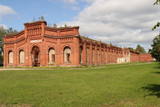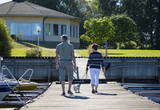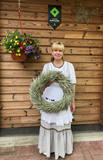| Nr | Nosaukums | Apraksts |
|---|---|---|
|
Andrupenes dabas takā var iepazīt sūnas, pārliecināties par sfagnu lielo ūdens uzsūkšanas spēju, gar laipas malām ieraudzīt apaļlapu raseni un purva dzērveni, apskatīt spilves, vaivariņus un purva vārnkāju, kā arī purva pasauli. Takas garums ~ 750m.
|
||
|
Putnu salas Atālu sētas rijā vietējā novadpētniece Ārija Gruberte vairāk nekā 20 gadu laikā ir vākusi sadzīves priekšmetus, kas lietoti Dvietes senlejas apkaimē. Ekspozīcijā apskatāmi dažādi akmens laikmeta, dzelzs laikmeta un viduslaiku priekšmeti, kas atrasti nejauši un liecina par cilvēku dzīvi vairāk nekā 10 000 gadu garumā. Atālu apmeklējums iepriekš jāpiesaka. |
||
|
Baltijā un Eiropā lielākā padomju aviācijas tehnikas (t.sk. militārās) kolekcija, kas tapusi vairāk kā 40 gadu ilgā periodā. Tā atrodas Rīgas lidostas teritorijā un ir publiski pieejama.
|
||
|
Manēža (celta 1903. – 1904.) bija Karostas militāro treniņu, vingrinājumu un svinīgu pasākumu norises vieta. Dienvidu piebūvē (nav saglabājusies) atradās neliela baznīciņa. Manēžā notika ģimnastikas uzvedumi un sacensības jātnieku veiklības vingrinājumos. Tajā rīkoja oficiālas maltītes garnizona matrožiem, kur vienlaikus apkalpoja līdz 3000 cilvēkiem. Diemžēl līdz mūsdienām ir saglabājušās tikai „plikas” ēkas sienas. Manēžas apskate no ārpuses un iekšpuses jebkurā laikā. Vienīgā šāda veida un izmēra slēgta tipa celtne Latvijā, kuras jumta pārsegumā bija iestrādātas stikla kārniņu joslas.
|
||
|
Viesnīca atrodas netālu no jūras, mierīgā vidē, tikai īsa gājiena attālumā no Ekenas centra Raseborgā. Tuvumā atrodas restorāni, veikali, dzelzceļa stacija un pludmales. |
||
|
Atrodas 2,5 km dienvidos no „Kalna Kaibēniem”, Ogres kreisajā krastā. Ap 300 gadus vecā rija, ko atjaunoja 2008. gadā ir uzskatāms par Baltijas (Eiropas) mērogā vienreizēju koka arhitektūras pieminekli. Šobrīd tā ir Latvijā lielākā senlaiku dzīvojamā rija. Iespējams, ka kādam var būt arī grūtības ar šī objekta atrašanu dabā. Apmeklējums iepriekš jāpiesaka: + 371 29266840. |
||
|
No Ludzas pilskalna paveras viens no interesantākajiem Latgales skatiem uz vecāko Latvijas pilsētu un tās vēsturisko centru, Lielo un Mazo Ludzas ezeru, Livonijas ordeņa pilsdrupām, Baznīckalnu, dievnamiem. Novadpētniecības muzeju, Amatnieku centru u.c. objektiem.
|
||
|
Dravās var iepazīt bišu dzīvi un iegādāties dažādziedu medu, propolisu, propolisa sedziņas, vaska sveces. Latvijā neparasts piedāvājums – apiterapija, kuras laikā dziedina ar senām metodēm – gultā, zem kuras ir novietoti bišu stropi (bišu radītais siltums, vibrācija, biolauks). |
||
|
Viens no skaistākajiem Latvijas ābeļdārziem (~ 10 ha un 30 ābolu šķirnes), kas iekārtots iespaidīga paugura nogāzēs, no kura augšdaļas skaidrā laikā var redzēt Rīgas jūras līča ūdeņus. Īpaši skaisti šeit ir ziedošu ābeļu laikā. Piedāvā ābolus un degustācijas. |
||
|
Alūksnes novada saimniecībā "Pauguri" kokamatnieks Jānis Vīksne izgatavo koka virpojumus - cibiņas, pulksteņus, pildspalvas, spēles, šūpoles un citas saimniecībā noderīgas lietas. Iespējams iegādāties kokamatniecības suvenīrus - dekoratīvus un praktiskus virpojumus no koka. Senlietu muzeja apskate - seni galdniecības darba galdi, ēveles, āmuri, sirpji, grābekļi, sējmašīna, pulksteņi, trauki u.c. Saimniecībā ir izveidota skatu platforma, no kuras paveras skats uz Hānjas augstienes ainavām Igaunijā, kā arī atpūtas vieta vasaras piknikam ar galdu, uguskura vietu un skulptūrām. |
||
|
Kodas ir progresīvs sidra zīmols no Dienvidigaunijas, kas pazīstams ar savu ilgtspējīgo un precīzo pieeju sidra darīšanai. Zīmols bioloģiski audzē vairāk nekā 30 ābolu šķirnes, nodrošinot autentiskas garšas bez mākslīgām piedevām. Kodas uzsver tīras, neatšķaidītas ābolu sulas izmantošanu savos sidros, sadarbojoties ar fermentācijas ekspertiem, lai pilnveidotu unikālas ražošanas metodes. Ilgtspēja ir viņu filozofijas pamatā – viņi ievēro bezatkritumu pieeju, pārveidojot ābolu blakusproduktus par stiprajiem dzērieniem, biezeņiem un citiem produktiem. Kodas 2021. gadā veica zīmola maiņu, paplašinot savu piedāvājumu, iekļaujot bezalkoholiskos dzērienus, stipros dzērienus un pārtikas produktus, apvienojot tradīcijas ar inovācijām. |
||
|
Saglabājusies tikai neliela daļa no varenajiem zariem, no kuriem resnākie ir atbalstīti ar stutēm, bet ozola dobo vidu no lietus un sniega ūdeņiem aizsargā jumtiņš. Latvijas un Baltijas resnākais parastais ozols (Quercus robur) un resnākais Baltijas koks. Viens no Ziemeļeiropas resnākajiem ozoliem. Ainavisks. Netālu no ozola atrodas autostāvlaukums, informācijas stends.
|
||
|
Trušu audzēšanas saimniecība "Trušu muiža" savā allaž tapšanas procesā esošajā garaušu muižas kompleksā piedāvā aplūkot 15 – 20 dažādu šķirņu trušus no visas pasaules, kā arī iegūt bildi ar trusi. Lieliska iespēja ciemoties trušu "Harmonijas un miera sētā", tos samīļot, pabarot. "Trušu muiža" iegūst aizvien jaunus kaimiņus un pilnveidojas. Iespēja iegādāties "Trušu muižas" greznumlietas. Vaislas truši un mīļdzīvnieki. Vasaras sezonā (jūnijs - augusts) gaidīs ciemos no otrdienas līdz svētdienai (11:00 – 18:00). Lielākas grupas, iepriekš vienojoties, uzņem arī citā laikā. |
||
|
Bijušajā Mīslera muižas parkā ir izveidots savdabīgs tematiskais ciemats, kur visas atrakcijas ir saistītas ar leģendām par vientiešiem, kas bija pazīstamas Vācijā jau pirms 400 gadiem.Vientieši ir jokdaru tēli, kas kļuva slaveni ar savu nepraktisko, bezjēdzīgo rīcību un anekdotiskajām izdarībām.Šeit Jūs varēsiet piedalīties vientiešu anekdotiskajos piedzīvojumu pārgājienos, darboties meistaru darbnīcās, nopirkt kādu vietējo suvenīru, ieturēt maltīti (grupām pēc iepriekšējā pasūtījuma) un pārnakšņot teltīs. |
||
|
Atrodas 1,2 km dienvidos no Ģipkas centra, otrpus Jūrmalas – Kolkas ceļam (P 131). Grūti noticēt, ka tagad redzamā un no laukakmeņiem būvētā baznīca ir tapusi pavisam nesen – pēc 1992. gada, jo iepriekšējā nodega padomju laikā – 1979. g. Ironisks ir apstāklis, ka baznīcas tornī pēc 2. pasaules kara atradās Dundagas mežniecības uguns novērošanas postenis. Ugunsgrēka laikā gāja bojā greznais altāris un ērģeles, taču altārgleznu „Kristus pie krusta” izglāba. Tagad dievnams atkal kalpo savam pamatmērķim. |
||
|
Nemunas loku reģionālais parks (Nemuno kilpų regioninis parkas) ir dibināts 1992. g. un tā mērķis ir augu, dzīvnieku, ainavas un ģeoloģisko dabas pieminekļu aizsardzība. Parks ietver piecus lielus Nemunas upes lokus, kuru centrā atrodas Birštonas – viens no nozīmīgākajiem Lietuvas kūrortiem. Nemunas loku stāvajos krastos vietām redzami iespaidīgi nogulumiežu atsegumi. No dabas daudzveidības un ainavas viedokļa nozīmīgas ir arī Nemunas pieteku dziļās gravas. Parkā sastopami veci nogāžu un gravu meži. Punes (Punia) un Prienu (Prienai) mežos aug Lietuvā augstākie koki. Kopumā parkā ir konstatētas 973 augu un 1713 dzīvnieku (zīdītāji, putni, abinieki, rāpuļi, kukaiņi u.c.) un 505 sēņu sugas. Kā nozīmīgi kultūras tradīciju turpinātāji ir jāpiemin Prienu kokapstrādes meistari, kas gatavo koka krustus. |
||
|
Strenču novada Jērcēnu pagasta zemnieku saimniecība “Veckūkuri” ir iekļauta Latvijas ražīgāko ganāmpulku topā. "Veckūri" ir piena pārstrāde, kas ražo netradicionālus piena produktus no savā saimniecībā iegūtā piena. Saimniecība ierindota arī to uzņēmumu vidū, kam piešķirti valsts eksporta padomes apbalvojumi “Latvijas Eksportprece 2015”. |
||
|
Vieni no lielākajiem Latvijas kazkopības produkcijas ražotājiem. Audzē ~ 300 tīršķirnes kazas (Alpu, Anglo, Vācu baltā dižciltīgā) un mājas cūkas kuiļus (vaislai). Ekskursija un iesaistīšanās kazu ganīšanā. Sākot no marta - kazlēnu apskate. Vairāku siera šķirņu degustācija, slaukšanas (ap 17:00 dienā) demonstrēšana. Piedāvā arī gaļas konservu degustāciju un iegādi. Produktiem nepievieno konservantus! Jaunums: saldējums no kazas piena. |
||
|
Maršruts ved caur vēsturisko Sēlijas un Latgales reģionu, tas sākas un beidzas Daugavpilī, otrā lielākajā pilsētā Latvijā. |
||
|
Mājas restorāns ''Dzīles'' atrodas Kārsavas novadā blakus Malnavas muižas parkam. Tas ir ģimenes uzņēmums, kas nodarbojas ar maizes un miltu izstrādājumu ražošanu. Saimniece gatavo sātīgus latgaliešu ēdienus un piedāvā lauku laubumus. Viesiem tiek rādīts, kā gatavo tortes un cep pīrāgus. Tāpat tiek organizēti branči - vēlās brīvdienu brokastis. Īpašais ēdiens ir pašceptā „Dzīļu maize”, kuras mīklā iejauc klijas, rozīnes, dzērveņu ievārījumu un linsēklas. Produkciju iespējams iegādāties gan maiznīcā uz vietas, gan Rēzeknes veikalā "Zaļais". Tiek piedāvātas darbnīcas, kurās iespējams izcept rupjmaizi vai saldskābmaizi pēc senču tradīcijām vai iemēģināt roku kādas jaunas un neparastas maizes tapšanā. Tāpat pieejama degustācija, kurā iespējams nogaršot 5 maizes veidus un beigās arī kūku vai asuškas. |
||



























